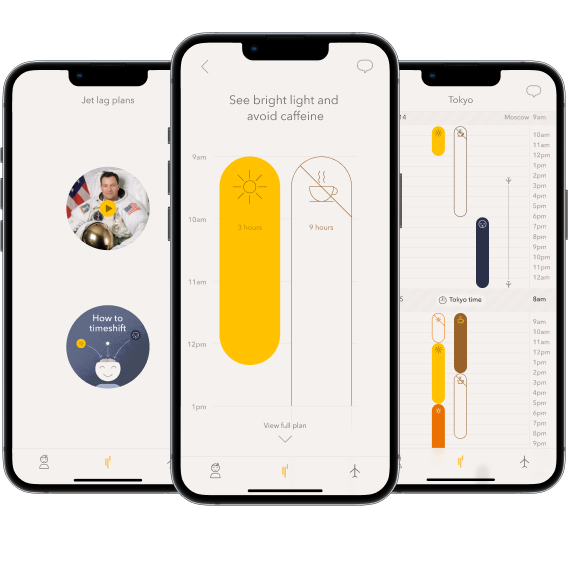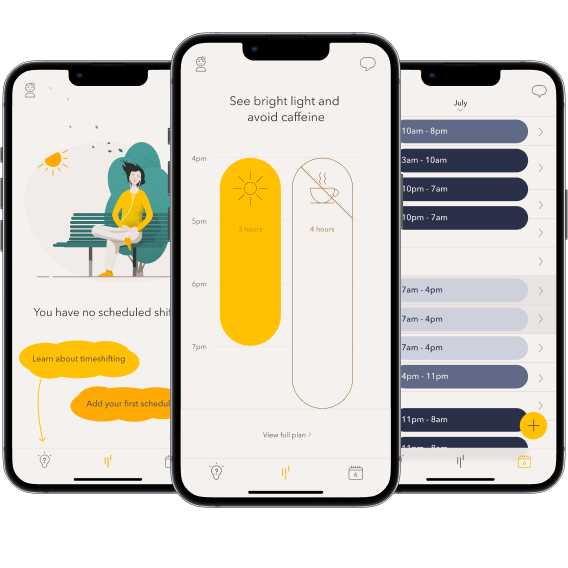Understanding your chronotype
What is a chronotype?
Your chronotype, sometimes also called diurnal preference, reflects your body's natural rhythm of when you feel most alert or tired throughout a 24-hour day. This biological pattern explains why some people spring out of bed at dawn feeling refreshed (morning types or "larks"), while others struggle to function before noon but become more alert and productive in the evening hours (evening types or "owls"). About 25% of people report being a ‘morning type’ or ‘evening type,’ with about half of the population falling somewhere between these extremes and showing only slight tendencies toward morning or evening preferences. Extreme types on either end of the spectrum comprise only about 10% of the population.
Chronotype is determined by two primary biological mechanisms: your circadian clock and homeostatic sleep regulation. The circadian clock generates near-24-hour rhythms in almost all physiological and behavioral functions, while sleep homeostasis governs how quickly you build up sleep pressure and how rapidly it dissipates while sleeping. Together, these systems create your unique daily rhythm of alertness and sleepiness.
This natural biological pattern influences nearly every aspect of your daily functioning—from productivity and performance to sleep quality and health. Understanding your chronotype isn't merely interesting—it's essential for optimizing your daily schedule, improving sleep quality, and enhancing your overall well-being in our 24/7 world.
The science behind your circadian clock
Your internal genetic circadian clock doesn't change over your lifetime, but your expressed chronotype—how those genetics translate into timing or behaviors —can change with age. The biological basis of chronotype lies in the suprachiasmatic nuclei (SCN), a cluster of approximately 50,000 cells in the hypothalamus that serves as the central circadian pacemaker.
This internal clock naturally runs on a cycle that doesn't exactly match Earth's 24-hour rotation. For most people, the natural period is slightly longer, averaging about 24.2 hours, but this can range from 23.5 to 25.0 hours across the population. Morning types typically have shorter internal clock periods (less than 24 hours), while evening types have longer periods (often greater than 24.5 hours).
This variation in internal clock speed creates what scientists call the "phase angle of entrainment"—how your internal biological rhythms align with the external light-dark cycle. This alignment significantly influences when you naturally prefer to sleep and when you perform at your best.
Sleep homeostasis interacts with your circadian rhythm to determine your chronotype. Morning types typically accumulate sleep pressure more quickly throughout the day and dissipate it more rapidly during sleep than evening types. This difference explains why morning types feel sleepy earlier in the evening and why they tend to wake naturally early, often feeling alert and ready to go. Evening types build sleep pressure more slowly, meaning that they cannot go to sleep as early as morning types and feel more alert in the evening, and they also take longer to fully dissipate sleep pressure, contributing to their morning grogginess if they cannot wake up at their natural time.
These differences in sleep homeostasis have other implications. Evening types often accumulate more "sleep debt" during the workweek when forced to wake earlier than their biology prefers, leading to excessive "recovery sleep" on weekends. Understanding both your circadian rhythm and your sleep homeostatic tendencies provides a more complete picture of your chronotype and how to work with it.
How chronotype affects daily performance and productivity optimization
The behavioral differences between morning and evening types are remarkably consistent despite all the factors that can affect daytime alertness. Morning types typically experience high alertness early in the day which gradually declines, while evening types start with lower morning alertness that remains more stable or improves throughout the day.
These differences arise because morning types wake at a relatively later point in their internal circadian day—they've already passed through the lowest point of their alertness cycle before waking. Evening types, conversely, wake earlier in their circadian cycle, explaining their morning grogginess and stronger evening performance.
This pattern affects not just how you feel but also your cognitive abilities, physical performance, and even your emotional regulation throughout the day. Research shows that performing tasks at your optimal circadian time can improve performance by 10-20% compared to working at your non-optimal time. Understanding these patterns is crucial for productivity optimization based on your unique biological rhythms.
Chronotype changes throughout life
While your core genetic clock remains unchanged, how that clock interacts with the sleep homeostat changes your chronotype throughout the lifespan. For example, most teenagers become more evening-type throughout adolescence, which represents a real biological delay in their circadian clock, and a slowing of their buildup in sleep pressure, and not due to social preferences or other factors.
From early adulthood, we typically become more morning-type—not because our internal clock speeds up but because our sleep regulation system changes. As we get older, alterations in the sleep homeostasis system mean that we can't stay awake as long or sleep as for as long as we used to, leading to earlier wake times, earlier light exposure, and consequently, a shift in our circadian clock to an earlier time.
This process explains why teenagers naturally want to stay up late and sleep in, while older adults often find themselves waking early regardless of when they go to bed. These age-related chronotype changes are normal biological processes, not personal failings or due to habits. Understanding these changes can help families adapt their sleep schedules and expectations accordingly.
Chronotype and jet lag: Understanding time zone travel
Your chronotype significantly impacts how easily you adapt to new time zones when traveling. If you're a morning type with a circadian clock running faster than 24 hours, you'll likely find it easier to travel eastward—your body naturally already wants to shift earlier each day. Evening types, with clocks running slower than 24 hours, typically adapt more easily when traveling westward.
This relationship explains why some people adjust quickly to certain trips while struggling with others. The mismatch between your chronotype and travel direction can extend recovery time from jet lag by several days, affecting everything from sleep quality to cognitive performance and digestion.
For rapid re-adaptation of your circadian clock to the new time zone, the timing of light exposure and light avoidance becomes crucial. Light exposure can shift the clock earlier (phase advance) or later (phase delay) depending on the circadian time of the exposure. Exposure to light (or dark) at the wrong time can shift the circadian clock in the wrong direction, making symptoms worse. A graph called a Phase Response Curve (PRC) describes how light timing determines the direction and magnitude of a timeshift.
Without understanding your chronotype and the PRC, you might inadvertently expose yourself to light at times that shift your circadian clock in the wrong direction, making your jet lag worse. Melatonin can also reset the circadian clock and has its own PRC so can be used to speed up circadian adaptation when timed correctly.
Jet lag is history.
Timeshifter is the most-downloaded and highest-rated jet lag app in the world, and is using the same advanced algorithms applied by Axiom Space.

Chronotype and shift work adaptation
Shift work presents particular challenges for circadian rhythms, and your chronotype determines how well you can adapt to non-standard work schedules. Morning types typically struggle more with night shifts, while evening types find them somewhat easier to tolerate—although no one fully adapts to night shift schedules.
The mismatch between your internal clock and your work and sleep schedule contributes to what researchers call "circadian misalignment." This misalignment is associated with increased risks of accidents, injuries, and reduced productivity, and in the long term, an increase in chronic diseases such as diabetes and metabolic disorders, cardiovascular disease, depression, and even certain cancers.
Understanding your chronotype can help you minimize these risks by allowing you to select shifts that better align with your natural rhythms when possible, or to strategically time your light exposure and light avoidance to facilitate adaptation. Even small improvements in alignment can significantly reduce health risks and improve performance for shift workers who must operate outside their natural sleep schedule.
A better way to shift work
Timeshifter’s new revolutionary app for shift workers is using the same algorithms applied by Axiom Space's mission control. The app helps shift workers optimize their sleep, alertness, health, and quality of life.

Determining your chronotype
You can identify your chronotype by observing your natural sleep patterns and energy fluctuations when free from external schedules (for example during vacations). Consider when you naturally fall asleep and wake up without alarms, and when you feel most mentally sharp and physically energetic.
Understanding whether you're a morning type, evening type, or somewhere in between provides powerful information for optimizing your daily schedule. This knowledge allows you to align important activities with your peak performance times and schedule less demanding tasks during your natural energy dips.
Optimizing your environment for your chronotype
Creating lighting environments that support your chronotype can dramatically improve your well-being. During your biological day, exposure to bright, blue-enriched light (5000-6500K "cool" white light) enhances alertness and performance. During your biological evening, dim, warm-spectrum light (2700-3000K) increases sleepiness and prepares your brain for sleep.
Electronic devices emit particularly bright, blue-enriched light that can be beneficial during your biological day but disruptive during your evening hours. Using "night mode" settings or blue-blocking software on your devices can help manage light exposure. Dark sunglasses can also reduce light exposure when needed to.
These environmental modifications are particularly important for evening types who must wake early for work or morning types who need to stay up later for social events. Strategically managing your light environment helps bridge the gap between social demands and your biological preferences, improving sleep quality and daytime functioning.
Leveraging chronotype for optimal health
Beyond performance and productivity, your chronotype impacts health and well-being including risk of metabolic disorders, and immune function. Research shows that living against your chronotype—such as evening types forced into early work schedules—increases the risk of chronic disease and may even reduce longevity.
Timing meals according to your chronotype, sometimes called ‘chrononutrition,’ can also improve health. Generally, concentrating caloric intake during your biological day and avoiding large meals during your biological night optimizes digestion and metabolism, but this can be further adjusted based on your chronotype . Similarly, while afternoon exercise is typically the best time to perform, the timing and intensity can also be optimized to your individual chronotype.
Even medication timing can be adjusted based on chronotype. The same medication taken at different circadian times can show significant variations in effectiveness and side effects. A morning type might need to take the same medication several hours earlier than an evening type for optimal results. This emerging field of chronopharmacology recognizes the importance of biological rhythms in medical treatment.
Practical applications for daily life and sleep schedule
Understanding your chronotype allows you to design your ideal day—scheduling challenging cognitive tasks, physical activities, and social interactions when your body is naturally primed for them. Morning types might schedule important meetings before noon, while evening types might reserve morning hours for routine tasks and tackle complex problems in the afternoon.
For better sleep quality, maintain consistent sleep timing aligned with your chronotype when possible. When social obligations require deviating from your natural timing, use strategic light exposure to help shift your rhythms temporarily. Consistency remains crucial—regular sleep-wake patterns strengthen your circadian synchronization regardless of chronotype.
While society often favors morning types with standard 9-to-5 schedules, the increasing flexibility of remote work offers new opportunities for evening types to align work hours with their biological preferences. This chronotype-aligned scheduling improves not just productivity but overall health and quality of life. Working with your biology rather than against it helps optimize performance across all domains of life.
Understanding your chronotype is about working with your biology rather than against it. By aligning your activities with your natural circadian rhythms, you can optimize performance, improve sleep, reduce health risks, and enhance your overall well-being in our 24/7 world.



